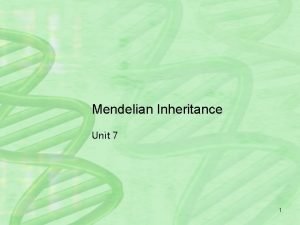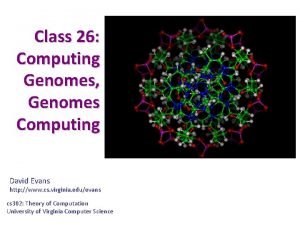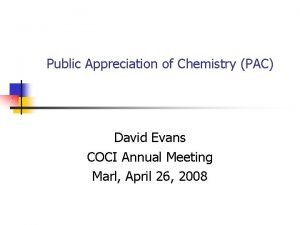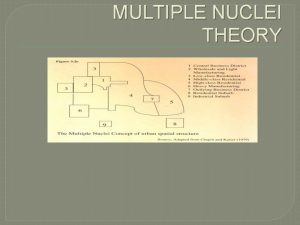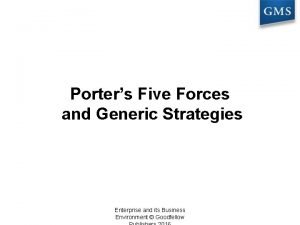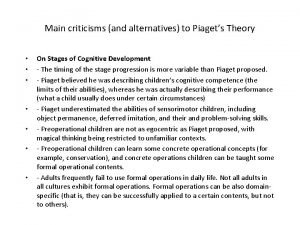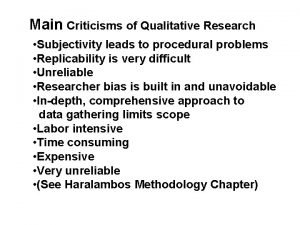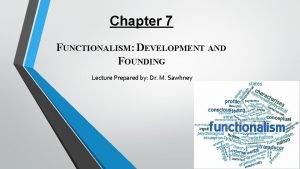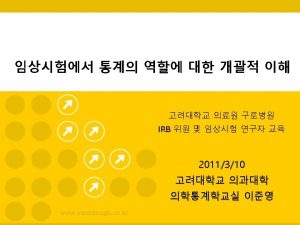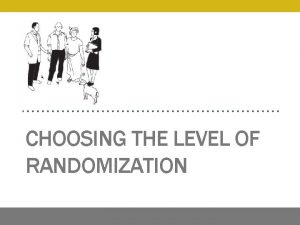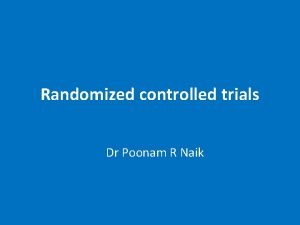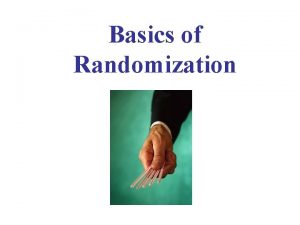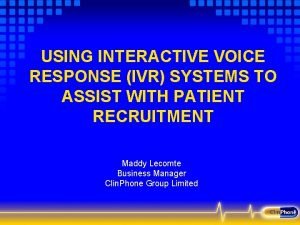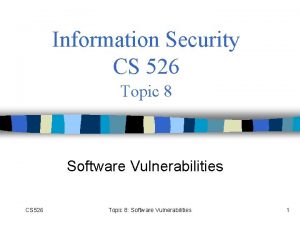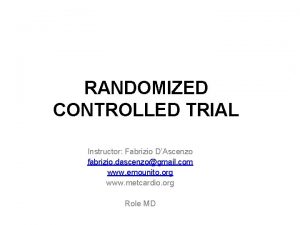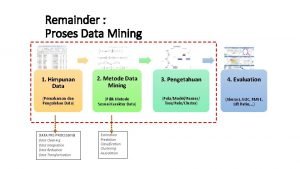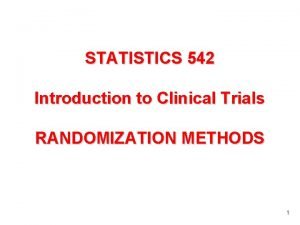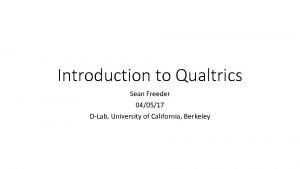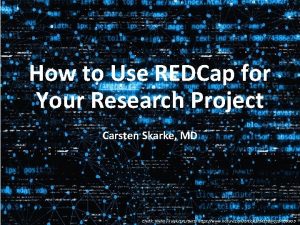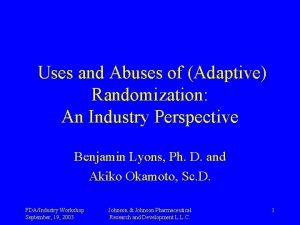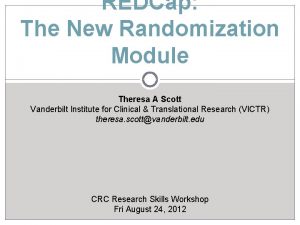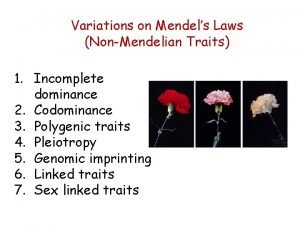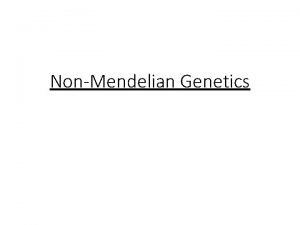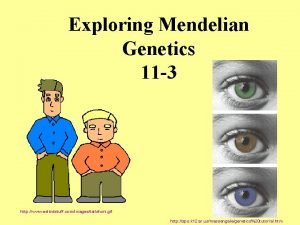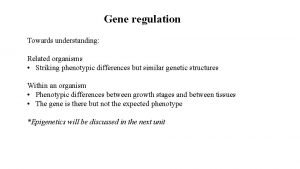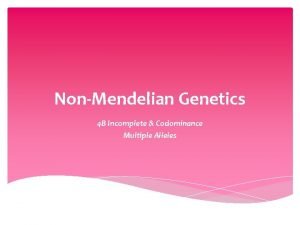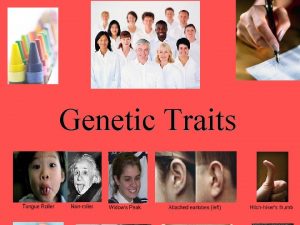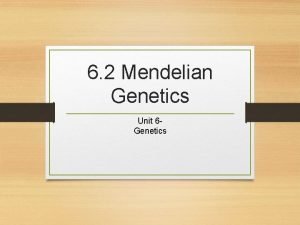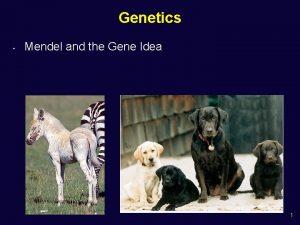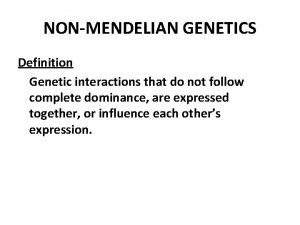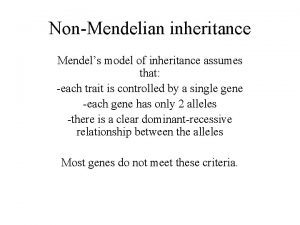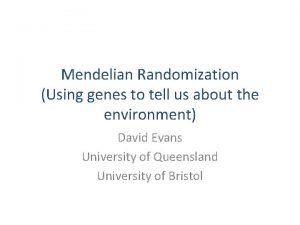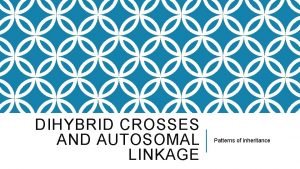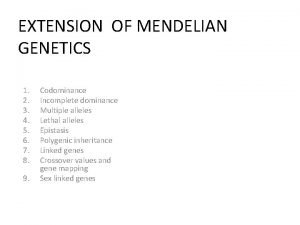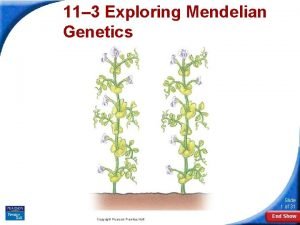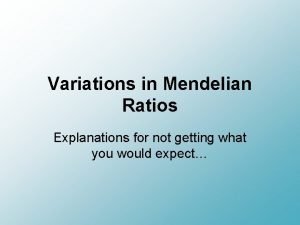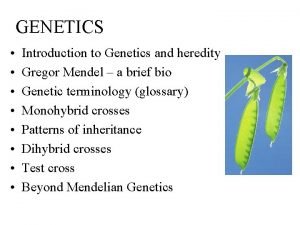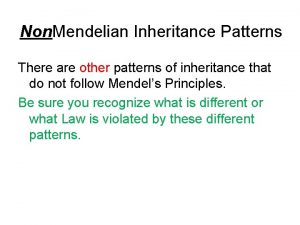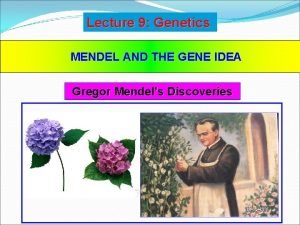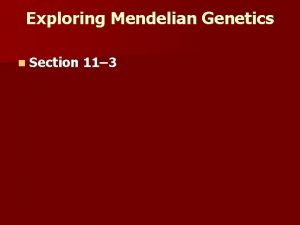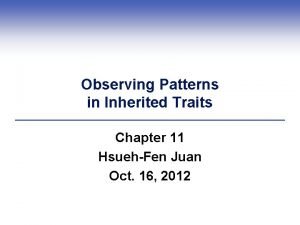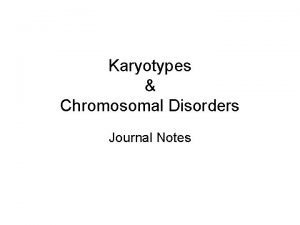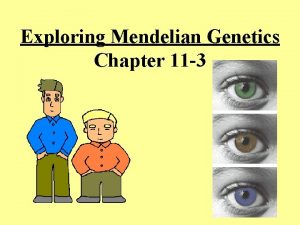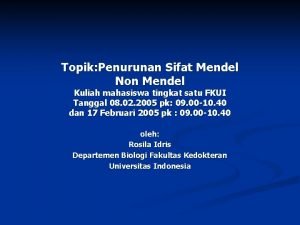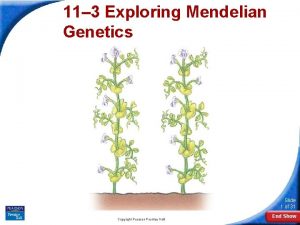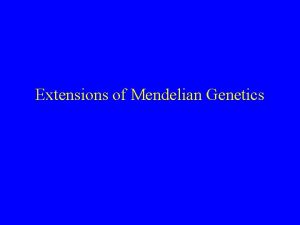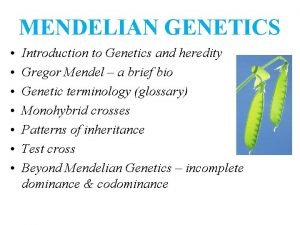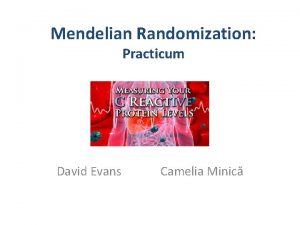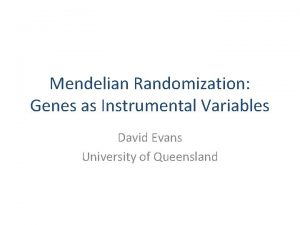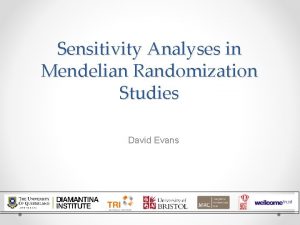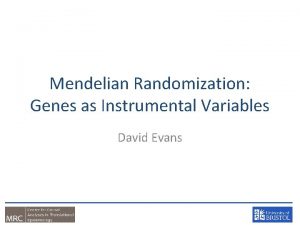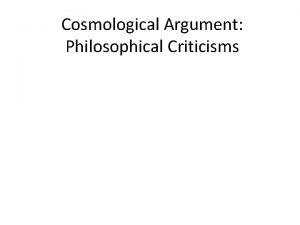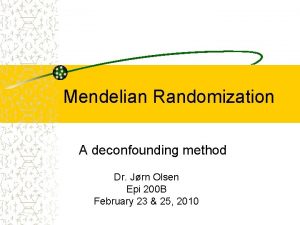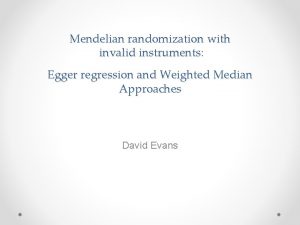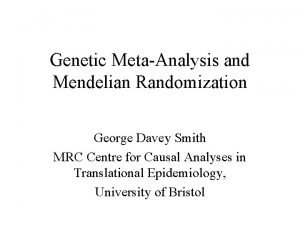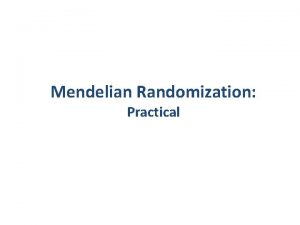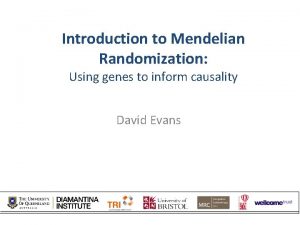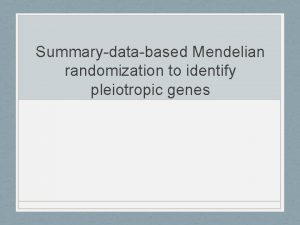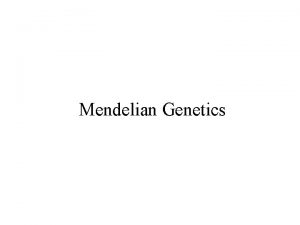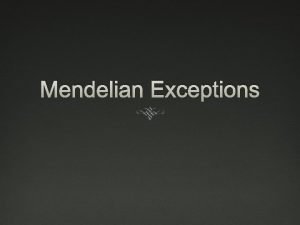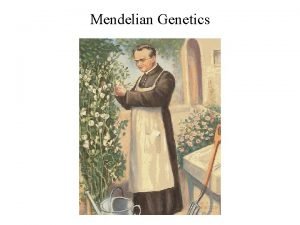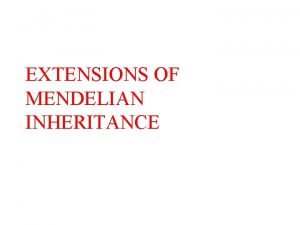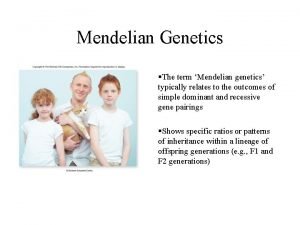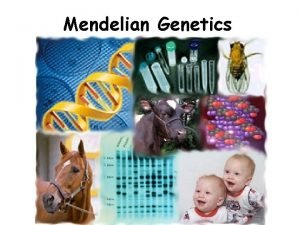Mendelian Randomization David Evans Some Criticisms of GWA











































































- Slides: 75

Mendelian Randomization David Evans

Some Criticisms of GWA Studies… • So you have a new GWAS hit for a disease… so what!? • You can’t change people’s genotypes (at least not yet) • You can however modify people’s environments… • Mendelian Randomization is a method of using genetics to inform us about associations in traditional observational epidemiology and MUCH more…

This Session • Determining causality in epidemiology • Mendelian randomization (MR) • Examples of MR • Extensions to MR • Mining the Phenome / Hypothesis Free Causality • Practical

RCTs: the Gold Standard in Inferring Causality RANDOMISED CONTROLLED TRIAL Randomization makes causal inference possible RANDOMIZATION METHOD EXPOSED: INTERVENTION CONTROL: NO INTERVENTION CONFOUNDERS EQUAL BETWEEN GROUPS OUTCOMES COMPARED BETWEEN GROUPS

The Need for Observational Studies • Randomized Controlled Trials (RCTs): – Not always ethical or practically feasible eg anything toxic – Expensive, requires experimentation in humans – Should only be conducted on interventions that show very strong observational evidence in humans • Observational studies: – Association between environmental exposures and disease measured in observational designs (non-experimental) eg case-control studies or cohort studies – Reliably assigning causality in these types of studies is very limited

CHD risk according to duration of current Vitamin E supplement use compared to no use RR Rimm et al NEJM 1993; 328: 1450 -6



Percent Use of vitamin supplements by US adults, 1987 -2000 Source: Millen AE, Journal of American Dietetic Assoc 2004; 104: 942 -950

Vitamin E supplement use and risk of Coronary Heart Disease 1. 0 Stampfer et al NEJM 1993; 328: 144 -9; Rimm et al NEJM 1993; 328: 1450 -6; Eidelman et al Arch Intern Med 2004; 164: 1552 -6

“Well, so much for antioxidants. ”

MANY OTHER EXAMPLES VITAMIN C, VITAMIN A, HRT, MANY DRUG TARGETS……. WHAT’S THE EXPLANATION?

Vitamin E levels and confounding risk factors: Childhood SES Manual social class No car access State pension only Smoker Obese Daily alcohol Exercise Low fat diet Height Leg length Women’s Heart and Health Study Lawlor et al, Lancet 2004

Confounding Smoking, diet, alcohol, socioeconomic position…. Confounders Exposure Vitamin E Outcome Heart disease

Classic limitations to “observational” science • Confounding • Reverse Causation • Bias

Mendelian randomization How can it help observational epidemiology?

What is Mendelian randomization? • Mendelian randomization (MR) is an epidemiological technique that uses genetic variants as proxy measures for an environmental exposure • It is an application of “Instrumental Variable” (IV) analysis: – it uses genetic variants as ‘instruments’ for the exposure of interest. An IV is a variable that is only associated with an outcome because of its association with the exposure Confounders Instrument Exposure Outcome

What does MR do? • Assess causal relationship between two variables • Estimate magnitude of causal effect How does it do this? By harnessing Mendel’s laws of inheritance

Mendel’s Laws of Inheritance 1. Segregation: alleles separate at meiosis and a randomly selected allele is transmitted to offspring 2. Independent assortment: alleles for separate traits are transmitted independently of one another Mendel in 1862

Mendelian randomization and Mendel’s Laws The laws of Mendelian genetics imply: Groups of individuals defined by genotype should only differ with respect to the locus under study [and closely related loci in LD with that locus] This means genotypes can proxy for some modifiable risk factors because: There should be no confounding of genotype by behavioural, socioeconomic or physiological factors Mendel in 1862 [except factors influenced by nearby loci, or due to population stratification]

Fisher and Confounding “Generally speaking the geneticist, even if he foolishly wanted to, could not introduce systematic errors into comparison of genotypes, because for most of the relevant time he has not yet recognized them” Fisher (1952)

Mendelian randomization and RCTs MENDELIAN RANDOMIZATION RANDOMISED CONTROLLED TRIAL + independent assortment RANDOM SEGREGATION OF ALLELES EXPOSED: FUNCTIONAL ALLELLES CONTROL: NULL ALLELLES CONFOUNDERS EQUAL BETWEEN GROUPS OUTCOMES COMPARED BETWEEN GROUPS RANDOMISATION METHOD EXPOSED: INTERVENTION CONTROL: NO INTERVENTION CONFOUNDERS EQUAL BETWEEN GROUPS OUTCOMES COMPARED BETWEEN GROUPS

Mendelian randomization: Smoking and Lung Cancer RANDOMISED CONTROLLED TRIAL MENDELIAN RANDOMIZATION + independent assortment RANDOM SEGREGATION OF ALLELES Heavy Smokers: C/C Light/Non Smokers: C/T or T/T CONFOUNDERS EQUAL BETWEEN GROUPS LUNG CANCER COMPARED BETWEEN GROUPS RANDOMISATION METHOD EXPOSED: SMOKERS CONTROL: NON SMOKERS CONFOUNDERS EQUAL BETWEEN GROUPS LUNG CANCER COMPARED BETWEEN GROUPS

Mendelian Randomization: 3 Core Assumptions Confounders (2) X SNP (1) Exposure Outcome X (3) (1) SNP is associated with the exposure (2) SNP is NOT associated with confounding variables (3) SNP ONLY associated with outcome through the exposure

Calculating Causal Effect Estimates Confounders SNP Exposure Outcome βSNP-EXPOSURE ? β CAUSAL EXP-OUTCOME βSNP-OUTCOME After SNP identified robustly associated with exposure of interest: - Wald Estimator - Two-stage least-squares (TSLS) regression

Calculating Causal Effect Estimates Confounders SNP Exposure βSNP-EXPOSURE Outcome βCAUSAL EXP-OUTCOME βSNP-OUTCOME Causal effect by Wald Estimator* : βSNP-OUTCOME = βCAUSAL EXP-OUTCOME x βSNP-EXPOSURE *Can be used in different samples (“Two sample MR”)

Calculating Causal Effect Estimates Confounders SNP βSNP-WEIGHT Weight 0. 5 kg βCAUSAL WEIGHT-BP BP βSNP-BP BP and weight: 0. 9 mm. Hg Causal effect by Wald Estimator* : βSNP-OUTCOME βSNP-EXPOSURE = change in outcome per unit change in exposure *Can be used in different samples (“Two sample MR”) 0. 9 mm. Hg/allele 0. 5 kg/allele =1. 8 mm. Hg/kg

Calculating Causal Effect Estimates Confounders SNP β Exposure SNP-EXPOSURE ? β Outcome CAUSAL EXP-OUTCOME βPREDICTED VALUE-OUTCOME Two-stage Least Squares (2 SLS): (1) Regress exposure on SNP & obtain predicted values (2) Regress outcome on predicted exposure (from 1 st stage regression) (3) Adjust standard errors *Needs to be done in the one sample (“Single sample MR”)

Calculating Causal Effect Estimates Confounders SNP β Exposure SNP-EXPOSURE ? β Outcome CAUSAL EXP-OUTCOME βPREDICTED VALUE-OUTCOME Two-stage Least Squares (2 SLS): (1) Regress exposure on SNP & obtain predicted values (2) Regress outcome on predicted exposure (from 1 st stage regression) (3) Adjust standard errors This gives you: difference in outcome per unit change in (genetically-predicted) exposure Genetically determined exposure “randomized” can ascribe causality (if assumptions are met) *Needs to be done in the one sample (“Single sample MR”)

MR Example using CRP • C-Reactive Protein (CRP) is a biomarker of inflammation • It is associated with BMI, metabolic syndrome, CHD and a number of other diseases • It is unclear whether these observational relationships are causal or due to confounding or reverse causality • This question is important from the perspective of intervention and drug development

Using a genetic instrument for proinflammatory CRP U CRP genotype CRP Cardiometabolic traits TWO ALTERNATIVES 1. If CRP DOES NOT causally affect cardiometabolic traits: CRP gene variant should NOT be related to cardiometabolic traits 2. If CRP CAUSALLY affects metabolic traits: CRP gene variant should also be related to these metabolic traits

“Bi-directional Mendelian Randomization”: Testing causality and reverse causation ? FTO Genotype CRP BMI ? CRP Genotype


Limitations to Mendelian Randomization 1 - Population stratification 2 - Canalisation (“Developmental compensation”) 3 - The existence of instruments 4 - Pleiotropy 5 - Power (also “weak instrument bias”)

Pleiotropy • Genetic variant influences more than one trait • Pleiotropy only violates MR’s assumptions if it involves a pathway outside that of the exposure and is a pathway that affects your outcome Violation B 1 B 2 Outcome G Exposure B 1 B 2 G

Power and Weak Instruments • Power: – Genetic variants explain very small amounts of phenotypic variance in a given trait – VERY large sample sizes are generally required • Weak instruments: – Genetic variants that are weak proxies for the exposure – Results in biased causal estimates from MR • Different impact of the bias from weak instruments: – Single Sample MR: to the confounded estimate – Two-Sample MR: to the null

Using Multiple Genetic Variants as Instruments Palmer et al (2011) Stat Method Res • Allelic scores • Testing multiple variants individually • Meta-analyse individual SNPs

http: //cnsgenomics. com/shiny/m. Rnd/

Using MR to Inform Mother-Offspring Associations

U Maternal SNP Maternal Exposure Child Outcome



Kelly Y, Sacker A, Gray R et al. J Epidemiol Community Health (2010), doi: 10. 1136/jech. 2009. 103002

Kelly Y, Sacker A, Gray R et al. J Epidemiol Community Health (2010), doi: 10. 1136/jech. 2009. 103002

Kelly Y, Sacker A, Gray R et al. J Epidemiol Community Health (2010), doi: 10. 1136/jech. 2009. 103002

Maternal Alcohol Dehydrogenase and Offspring IQ

IQ Change Alcohol dehydrogenase (ADH) risk allele score in offspring and offspring IQ, stratified by maternal alcohol intake during pregnancy Women not drinking in pregnancy All women Women drinking during pregnancy P value for interaction of risk allele score and drinking during pregnancy equals 0. 009 Lewis S et al, PLo. S One Nov 2012.


Two Step Mendelian Randomization (Mediation Analysis) FTO BMI CHD LDL HMGCR • How much of the effect of BMI on CHD is mediated through LDL? • Can be done using two sample MR

Multivariable MR SNP 1 SNP 2 Fat Mass Bone Mineral Density (Osteoporosis) SNP 3 SNP 4 SNP 5 Lean Mass

Mendelian Randomization and Drug Targets Thanks Sek Kathiresan

Late Stage Failure in Drug Trials Cook et al. (2014) Nat Rev Drug Disc

Association of LDL-C, HDL-C, and risk for coronary heart disease (CHD) LDL-C HDL-C 302 K participants in 68 prospective studies Emerging Risk Factors Collaboration, JAMA 2009

LDL and CHD Risk Ference et al, JACC 2012

HDL: endothelial lipase Asn 396 Ser • • 2. 6% of population carry Serine allele higher HDL-C No effect on other lipid fractions No effect on other MI risk factors Edmondson, J Clin Invest

LIPG N 396 S and plasma HDL-C HDL Difference 396 S carriers have 5. 5 mg/dl higher HDL-C P<10 -8

After testing in 116, 320 people, summary OR for LIPG Asn 396 Ser is 0. 99

Individuals who carry the HDL-boosting variant have the same risk for heart attack as those who do not carry the variant




Mining the Phenome

“Mining the Phenome” (Using Allelic Scores) SNP 1 SNP 2 SNP 3 SNP 4. . . SNPN Evans et al. (2013) PLo. S Genet Intermediate (Gene expression) (Methylation) (Metabolomics) (Proteomics) Disease

Using Anonymous Genome-wide Allelic Scores to Inform Causality (? )

GW Scores NOT Good For Causal Inference

Mining the Phenome and Hypothesis. Free Causality Evans & Davey Smith (2015) Ann Rev Genom Hum Genet

Transcriptome-wide Association Studies

MR Base Jie “Chris” Zheng http: //www. mrbase. org/ Gib Hemani Phil Haycock






Useful References Bowden et al (2015). Mendelian randomization with invalid instruments: effect estimation and bias detection through Egger regression. Int J Epidemiol, 44, 512 -25. Bowden et al (2016). Consistent estimation in Mendelian randomization with some invalid instruments using a weighted median estimator. Genet Epidemiol, 40, 304 -14. Brion et al (2013). Calculating statistical power in Mendelian randomization studies. Int J Epidemiol, 42(5), 1497501. Burgess & Thompson (2015). Multivariable Mendelian randomization: the use of pleiotropic genetic variants to estimate causal effects. Am J Epidemiol, 181, 251 -60. Davey-Smith & Hemani (2014). Mendelian randomization: genetic studies for causal inference in epidemiological studies. Hum Mol Genet, 23(1), R 89 -98. Davey-Smith & Ebrahim (2003). “Mendelian randomization”: can genetic epidemiology contribute to understanding environmental determinants of disease? IJE, 32, 1 -22. Evans & Davey-Smith (2015). Mendelian randomization: New applications in the coming age of hypothesis free causality. Annu Rev Genomics Hum Genet, 16, 327 -50.

Practical
 Family resemblance test
Family resemblance test Gwa weebly
Gwa weebly David evans uva
David evans uva Dogma evans ga
Dogma evans ga David evans chemistry
David evans chemistry Multiple nuclei model examples
Multiple nuclei model examples New vocationalism sociology definition
New vocationalism sociology definition Criticisms of vocational education
Criticisms of vocational education Criticisms of the sick role
Criticisms of the sick role Neo luddite criticisms of computer technology
Neo luddite criticisms of computer technology David parentocracy
David parentocracy Michael porter's generic strategies
Michael porter's generic strategies Criticisms of piagets theory
Criticisms of piagets theory Criticisms of qualitative research
Criticisms of qualitative research Lasting impacts of the new deal
Lasting impacts of the new deal Natural law vs utilitarianism
Natural law vs utilitarianism Criticisms of functionalism
Criticisms of functionalism Symbolic interactionist perspective
Symbolic interactionist perspective Block randomization example
Block randomization example Level of randomization
Level of randomization Permuted block randomization
Permuted block randomization Types of randomization
Types of randomization Randomization
Randomization Interactive voice response system randomization
Interactive voice response system randomization Address space layout randomization
Address space layout randomization Stratified randomization
Stratified randomization Randomization based on remainder
Randomization based on remainder Stratified randomization
Stratified randomization Randomize blocks in qualtrics
Randomize blocks in qualtrics Upenn redcap
Upenn redcap Forced randomization
Forced randomization Redcap randomization
Redcap randomization Ice cream countable
Ice cream countable Some may trust in horses
Some may trust in horses Contact force
Contact force Sometimes you win some
Sometimes you win some Some say the world will end in fire some say in ice
Some say the world will end in fire some say in ice Sometimes you win some
Sometimes you win some Some say the world will end in fire some say in ice
Some say the world will end in fire some say in ice Non mendelian law
Non mendelian law Codominance
Codominance 11-3 exploring mendelian genetics
11-3 exploring mendelian genetics Recessive epistasis
Recessive epistasis Multiple alleles
Multiple alleles Mendelian laws
Mendelian laws Mendelian traits
Mendelian traits Mendelian genetics punnett square
Mendelian genetics punnett square Mendelian law of inheritance
Mendelian law of inheritance Mendelian inheritance pattern
Mendelian inheritance pattern Describe incomplete dominance
Describe incomplete dominance Section 1 chromosomes and phenotype study guide a
Section 1 chromosomes and phenotype study guide a Non mendelian law
Non mendelian law Drug
Drug Chapter 7 extending mendelian genetics answer key
Chapter 7 extending mendelian genetics answer key Chapter 7 extending mendelian genetics answer key
Chapter 7 extending mendelian genetics answer key Autosomal dihybrid cross
Autosomal dihybrid cross Chapter 10 sexual reproduction and genetics
Chapter 10 sexual reproduction and genetics Pprr x pprr punnett square
Pprr x pprr punnett square Section 11-3 exploring mendelian genetics
Section 11-3 exploring mendelian genetics Mendelian
Mendelian Blood type matrix
Blood type matrix Homozygous
Homozygous Mendelian pattern of inheritance
Mendelian pattern of inheritance Cystic fibrosis mendelian inheritance
Cystic fibrosis mendelian inheritance Section 11-3 exploring mendelian genetics answer key
Section 11-3 exploring mendelian genetics answer key Section 11-3 exploring mendelian genetics
Section 11-3 exploring mendelian genetics Mendelian genetics concept map
Mendelian genetics concept map Mendelian traits
Mendelian traits Difference between mendelian and chromosomal disorders
Difference between mendelian and chromosomal disorders Section 11-3 exploring mendelian genetics answer key
Section 11-3 exploring mendelian genetics answer key Pewarisan sifat non mendelian
Pewarisan sifat non mendelian Section 11-3 exploring mendelian genetics
Section 11-3 exploring mendelian genetics Non mendelian inheritance
Non mendelian inheritance Baldness genotype
Baldness genotype The scientific study of heredity *
The scientific study of heredity * Multiple alleles-
Multiple alleles-
